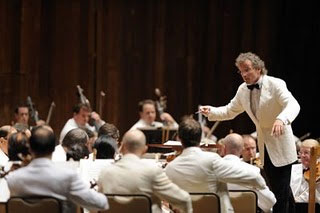by Daniel Hathaway

Reportedly the result of a scheduling issue with Lincoln Center, this unusual Blossom kickoff had the advantage of bringing music director Franz Welser-Möst back to town for three concerts over two summer weekends — and on Friday for a distinguished opening event however thematically remote from the national holiday.
Slovakian soprano Orgonášová joined the orchestra for Strauss’s Four Last Songs, 25 minutes of exquisite musical poetry which comprised the first half of the program. Written in Switzerland and completed in 1948, the songs were gathered, put in their current order and published posthumously, then premiered in 1950 in London by Strauss’s chosen soprano, Kirsten Flagstad and the Philharmonia Orchestra under Wilhelm Furtwängler. Twelve years later, Flagstad sang three of them with The Cleveland Orchestra under George Szell, who conducted all four with Elisabeth Schwarzkopf in 1958.
Three texts are by Hermann Hesse, the fourth — the first to be set to music — by Joseph von Eichendorff. As one might expect from an octogenarian composer whose works often contained autobiographical elements, the poems are mostly concerned with endings: of the summer (September), and of the day (Beim Schlafengehen — At Bedtime and Im Abendrot — At Sunset), a metaphor for the end of life. The exception is the first song, a radiant little paean to the miracle of Spring.

Program commentator Hugh Macdonald has done Shostakovich’s listeners a public service by giving us permission not to try to understand the composer’s symphonies. “Music may be a language, but we don’t know what it means.”, he wrote. “Shostakovich was…a very private, not to say inscrutable, individual, leaving us free to adopt almost any view of his work without any certainty that our view will coincide with his.”
That seems especially true of the eighth symphony, written during the middle of the Second World War, which makes it ripe for historical interpretation. If you try to assign some deep tragic import to its more solemn passages, there are moments of comedy that knock your theory right on its ear, not to mention long periods of sheer, abstract music-making. But if you think of the eighth as a concerto for orchestra, you can thoroughly enjoy an hour’s worth of music that takes you on a long, winding journey full of purely sonic surprises: blatant interruptions from the percussion section; a cheerful mini-concerto for the piccolo (Mary Kay Fink); an energetic viola section solo mawkishly picked up by the jealous trombones, then by the timpani; a portentous Passacaglia that passes beautiful variations off among solo winds, then to an eerie gaggle of quivering flutes; a section solo by bassoonists who seem to have just wandered out of a bar. It’s all there, and it all may add up to nothing more than what happened between the beginning and the end of the piece.
Welser-Möst and the orchestra played Shostakovich’s brilliant patchwork-quilt of musical styles masterfully, changing moods on a dime and visiting the whole dynamic range from the whispering to the stentorian. The audience — having been duped by a false ending or two in the first movement — was wary of applauding until the very end but when they did, the ovation was loud and long.
Published on ClevelandClassical.com July 6, 2013
Click here for a printable version of this article.


